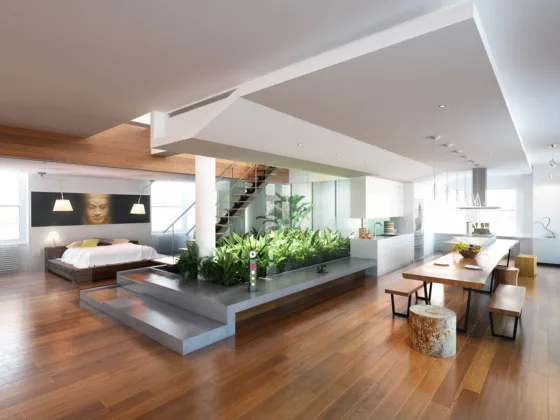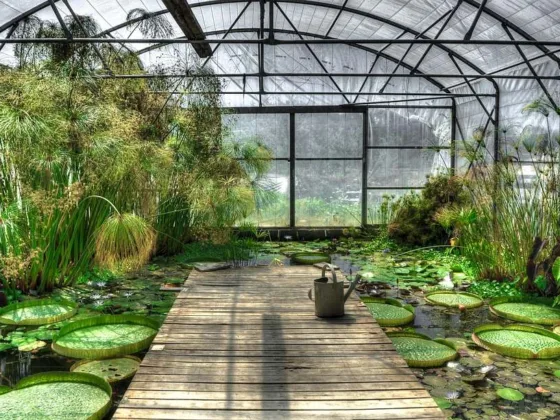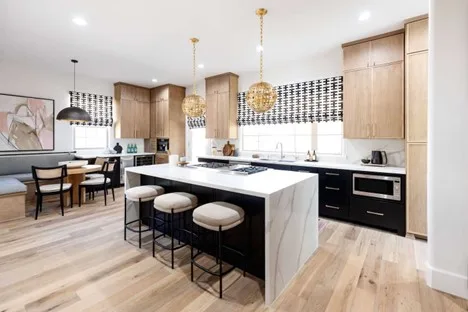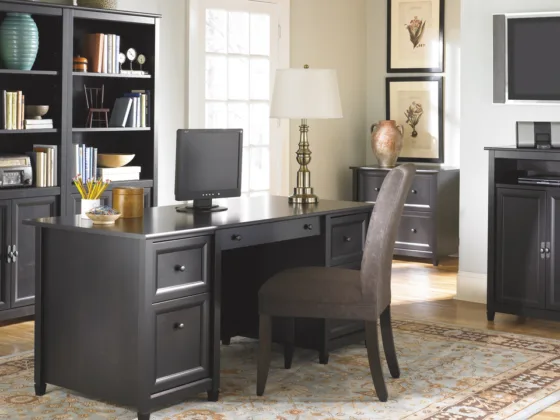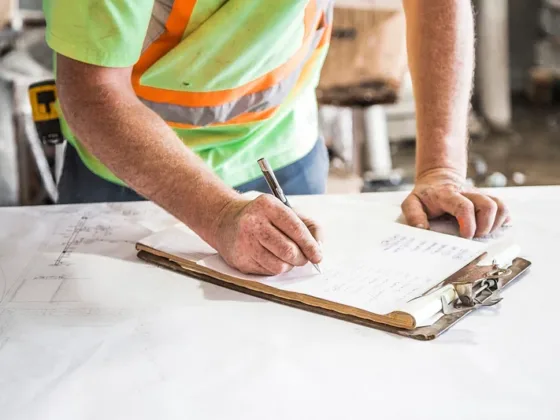Table of Contents Show
The current global trend leans towards a more sustainable lifestyle, from the surge in plant-based diets to the adoption of renewable energy sources. The push for greener alternatives extends to every facet of our daily lives, including housing. Indeed, green housing options have seen a remarkable increase in interest. A survey conducted by HSH unveiled that a significant 68% of home buyers are actively seeking an environmentally friendly home.
However, not everyone has the luxury of starting from scratch when it comes to embracing an eco-conscious lifestyle. For instance, large-scale installations like solar panels may not be feasible due to financial or structural constraints. It is here that small yet impactful changes can make a difference, and this has led to the burgeoning popularity of eco-friendly flooring.
While eco-friendly flooring is still a relatively new concept, it is rapidly gaining traction in the market. Initially regarded as a niche offering, these flooring options are becoming more mainstream as demand grows. However, this increased demand also means that some types of eco-flooring may come with a higher price tag.
But it’s not just their environmental benefits that make these options stand out – they also offer numerous advantages over traditional flooring options. From durability and aesthetics to health implications and maintenance requirements, each type of green flooring brings something unique to the table.
Each of these eco-flooring options offers a unique set of benefits and aesthetics that can help transform your home into a more sustainable living space. As the green trend continues to evolve, we can expect to see more innovative and affordable eco-friendly flooring options entering the market.
Let’s delve into some of the top eco-flooring options currently available:
1. Bamboo: A Sustainable Flooring Option

Bamboo, while mimicking the aesthetic appeal of traditional wood planks, offers a far more eco-friendly alternative to hardwood flooring. This is primarily because bamboo isn’t a type of wood at all – it’s grass.
Rapid Growth and Harvesting
Unlike trees, which can take decades to reach maturity, bamboo has a remarkably fast growth rate. It reaches maturity between just 3-5 years. Astonishingly, under optimal conditions, bamboo can grow almost ten feet in a single day. Currently, bamboo’s growth rate significantly outpaces its harvesting rate, making it a highly sustainable resource.
Lower Resource Consumption
Furthermore, as a grass species, bamboo requires much less water than trees to grow. This reduction in water usage adds another layer of environmental sustainability to this versatile material.
Benefits Over Hardwood
In addition to its remarkable environmental benefits, bamboo also holds several advantages over traditional hardwood flooring:
- Dimensional Stability: Bamboo expands and contracts less than hardwood does. This stability reduces the likelihood of buckling or gaps forming between planks.
- Durability: Despite its classification as grass, don’t underestimate the toughness of bamboo floors. It’s more resilient than many hardwood floors and can easily last for years under normal household conditions.
- Biodegradability: When your bamboo floor eventually wears out or you decide to change your decor style, rest assured knowing that this material is completely biodegradable with minimal environmental impact.
Versatility in Design
Bamboo floors come in an array of wood tones that beautifully complement any home decor aesthetic. From natural light tones for a minimalist look to darker carbonized browns for a rich and warm atmosphere, there’s a bamboo floor for every room design. With varied grain patterns and color tones available, you’re sure to find the perfect eco-friendly bamboo floor to suit your style and home’s character.
2. Cork: A Sustainable and Versatile Flooring Option

Often associated with cork boards and wine stoppers, cork is a relatively new player in the flooring industry. Its rise in popularity is largely due to its eco-friendly nature and unique properties that make it an excellent flooring material.
Harvesting Process
Cork comes from the bark of the cork oak tree, which mainly grows in the Mediterranean region. One of the most significant aspects of cork production is its sustainable harvesting process. The tree itself is not cut down during harvesting. Instead, only the bark is carefully stripped off, allowing the tree to regenerate over time. This process can take between 3 to 12 years.
Taking the concept of sustainability a step further, some brands are now incorporating recycled materials into their products. For example, using scraps from wine stoppers in their cork flooring.
Key Features of Cork Flooring
- Comfort: Cork flooring offers a soft underfoot feel, providing both cushioning and insulation. This makes it a comfortable choice for areas where you might stand for extended periods like kitchens or home offices.
- Noise Reduction: Due to its insulating properties, cork flooring also effectively reduces noise, which can be particularly beneficial in multi-level homes or apartments.
- Durability: Despite its softness, cork is incredibly durable. With proper care and maintenance, it can last anywhere from 10 to 30 years.
- Ease of Maintenance: Cork floors are easy to clean and maintain, which contributes to their longevity.
Design Options
Cork flooring is available in both planks and tiles, offering a wide range of design possibilities. It comes in natural shades that retain the unique look of cork bark and stained options for those seeking a specific color palette.
Whether you prefer a minimalist aesthetic or desire a bold and vibrant look, you’ll find plenty of options with cork flooring. Its versatility in design makes it easy to find the perfect match for any décor.
3. Natural Linoleum: A Resilient and Eco-friendly Flooring Choice

Often mistaken for vinyl, natural linoleum is a completely different material with its unique set of features. This environmentally friendly flooring option was prevalent before the introduction of synthetic vinyl in the 1940s. Today, it’s gaining popularity again, thanks to its eco-friendly properties and numerous benefits.
Composition and Eco-friendliness
Natural linoleum is made from a blend of all-natural materials – limestone, linseed oil, cork dust, wood fillers, and tree resins. These ingredients are renewable and biodegradable, resulting in flooring that has a low environmental footprint. Unlike PVC-based vinyl, natural linoleum does not release toxic gases into the environment during its production or disposal.
Variety in Design and Colour Options
The aesthetic versatility of natural linoleum is another factor contributing to its resurgence. It offers an array of patterns and colors, from neutral shades for a subtle look to bright hues for making a bold statement. Moreover, because the pigments are embedded throughout the material rather than just on the surface layer, it maintains its color even after years of wear and tear. This quality is referred to as being ‘colorfast’.
Health Benefits
Natural linoleum not only offers visual appeal but also promotes healthier living spaces. It boasts antimicrobial properties which inhibit the growth of bacteria and other microorganisms. This makes it an ideal choice for allergy-prone households where indoor air quality is paramount.
Durability and Water Resistance
Despite being made from natural materials, natural linoleum exhibits excellent durability. It can withstand heavy foot traffic while retaining its beauty over time. Additionally, this flooring option is water-resistant, making it suitable for rooms prone to moisture like bathrooms or laundry areas.
In summary, if you’re seeking a sustainable, versatile, health-promoting, and resilient flooring option, natural linoleum may be worth considering for your next home renovation project.
4. Engineered Hardwood: An Eco-Friendly Flooring Option That Stands the Test of Time

Engineered hardwood has been a staple in home design for years, and it’s easy to see why. This type of flooring marries aesthetics and sustainability, rendering it an excellent choice for eco-conscious homeowners.
What is Engineered Hardwood?
To put it simply, engineered wood flooring is a layered product composed of an actual thin slice of hardwood on top of a base of high-quality plywood. This construction means that less rare wood is used than in traditional solid wood flooring, making engineered hardwood a more sustainable choice.
Benefits of Engineered Hardwood
- Environmentally Friendly: The use of plywood layers in the construction of this type of flooring limits the amount of rare wood needed. This reduces the environmental impact associated with the harvesting of these materials.
- Aesthetically Pleasing: Despite its composite nature, engineered hardwood replicates the look and feel of a solid wood floor. It provides the charm and warmth that homeowners seek from wooden floorings.
- Cost-Effective: Engineered hardwood tends to be one of the more affordable environmentally friendly flooring options available on the market. Its main component being plywood rather than rare wood contributes to its lower cost.
- Versatile: There is a wide array of hues available in engineered wood flooring, ranging from light shades to dark grains. This ensures you can find an option that seamlessly fits any room’s aesthetic.
- Easy Maintenance: This type of flooring is known for its easy upkeep requirements. Regular sweeping or vacuuming followed by occasional mopping should keep your floors looking great.
While engineered hardwood isn’t new to the world of home design, its popularity has been steadily increasing over time due to these compelling benefits. If you’re seeking an attractive, durable, and eco-friendly flooring option, engineered hardwood might just be the right choice for your home.
5. Glass Tiles: An Eco-Friendly Flooring Option

Glass tiles are a fascinating choice in the arena of eco-friendly flooring options. They are produced from materials that have been recycled, primarily from beer and wine bottles that have been sent for recycling. This innovative material was initially gaining popularity as a choice for kitchen and bathroom walls. Nowadays, it is increasingly being used as a flooring option.
Environmental Impact and Additional Benefits
Glass tiles not only contribute towards an eco-friendly environment but also come with a range of additional benefits:
- Non-Absorptive: Unlike some other materials, glass isn’t absorptive. This means that it won’t foster the growth of mold in damp environments. It’s an ideal material for rooms exposed to humidity such as bathrooms and kitchens.
- Stain Resistance and Durability: Another advantage of glass tiles is their resistance to staining. Whether you spill coffee or wine, you can simply wipe it off without leaving a trace. Additionally, this type of flooring is characterized by its durability, standing up well to daily wear and tear.
Aesthetic Appeal
The aesthetic versatility offered by glass tiles is virtually limitless. So whether you’re looking for bold colors to make a statement or subtle hues to blend with your existing decor, there’s a glass tile that will meet your needs.
- Color Range: From cool blues inspired by the sea to warm earth tones, there’s no shortage of color options when it comes to glass tiles. This makes it easy to find the perfect shade to match your room’s aesthetic.
- Patterns and Finishes: Besides colors, glass tiles also come in various patterns – from geometric designs to abstract swirls – and finishes – glossy or matte.
If you’re seeking an eco-friendly flooring solution that doesn’t compromise on style or functionality, consider incorporating glass tiles into your design plan.
Related:
Eco-Flooring Trends: A Growing Movement
In the world of home design, eco-flooring trends are undeniably on the rise. Although many of these options are currently considered niche and may come with a higher price tag, they’re gaining traction in the market. As their popularity continues to grow, it’s anticipated that these sustainable flooring options will become increasingly available, and hopefully, more affordable.
One common misconception about eco-friendly flooring is that you’re limited in terms of aesthetic choices. However, this couldn’t be further from the truth. The variety of eco-friendly flooring materials means there’s a wide array of hues, colors, and finishes to choose from.
From natural wood tones to bright colors and patterns, there’s no shortage of variety when it comes to designing an eco-conscious interior. Whether you prefer understated elegance or bold and vibrant designs, you can easily find environmentally friendly flooring that matches any room’s aesthetic.
The Benefits of Eco-Flooring
Just like their traditional counterparts, most eco-friendly floors boast several appealing attributes:
- Durability: Many types of eco-flooring are designed to last for years, making them a sound investment for homeowners.
- Versatility: Some types are even suitable for bathrooms and other areas with high water exposure.
These benefits mean that choosing eco-friendly flooring doesn’t require any sacrifice in terms of functionality or performance.
The Future of Eco-Friendly Flooring
The demand for sustainable building materials is growing as more homeowners become aware of their environmental impact. As such, we can expect a wider array of eco-friendly flooring options to become available in the future.
Choosing eco-friendly flooring for your next home renovation project is not just a trendy decision—it’s also a responsible one. By doing so, you’re contributing to a larger movement towards greener homes and a more sustainable future.

FAQs(Frequently Asked Questions)
Some top sustainable choices for eco-friendly flooring include bamboo, cork, natural linoleum, engineered hardwood, and glass tiles.
Bamboo gives the effect of a traditional plank, but it is much more sustainable due to its rapid growth and harvesting, lower resource consumption, versatility in design, and benefits over hardwood.
Cork is a sustainable choice for flooring because it is renewable and comes from the bark of the cork oak tree. Additionally, it offers key features such as comfort, design options, and durability.
Natural linoleum is not PVC-based like vinyl, making it a more eco-friendly option. It is composed of all-natural materials and offers a variety of design and color options, as well as health benefits.
Engineered hardwood is considered a good eco-friendly choice because it uses plywood layers in its construction, making it environmentally friendly. It also stands the test of time in home design.
Glass tiles are a sustainable option for eco-friendly flooring as they contribute towards an eco-friendly environment, offer aesthetic appeal, and are part of the growing movement of eco-flooring trends.




